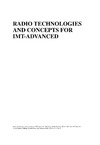Radio Technologies and Concepts for IMT-Advanced presents the findings of the Wireless World Initiative New Radio (WINNER) project in Framework Program 6 of the European Commission. It provides an insight into the key concepts and technologies for the IMT-Advanced radio interface, based on the collaborative research of manufacturers, network operators, research centres and universities within WINNER. The book covers the fundamental radio characteristics of a typical 4G wireless communication system, focusing on the transceiver’s chain from the physical layer to layers 2 and 3. Starting by defining realistic and futuristic usage scenarios, the authors provide in-depth discussion of key technologies including modulation and coding, link level procedures, spatial-temporal processing, multiple access schemes and inter-cell interference mitigation, channel estimation and newly developed channel models. Finally, a cost assessment and optimisation methodology is developed for different deployment concepts in order to assess a wireless system in a condition close to reality. The book provides an important system-level approach to the latest radio technologies in the field, and evaluates IMT-Advanced research in relation to international standardisation.
- Presents the research findings of IMT-Advanced radio interface from the
- WINNER project
- Covers the latest concepts for relaying, multiple access, radio resource control, flexible spectrum use, and ITU-R spectrum demand calculation
- Examines the most recent Multiple-Input, Multiple-Output (MIMO) techniques, and Distributed Antenna Systems (Coordinated Multipoint Transmissions)
- Describes a 4G system concept and all major building blocks
- Provides 4G propagation models and system-level evaluation methodologies
Content:
Chapter 1 Introduction (pages 1–12): Dr. Werner Mohr
Chapter 2 Usage Scenarios and Technical Requirements (pages 13–38): Dr. Marc Werner and Mr. Paulo Jesus
Chapter 3 WINNER II Channel Models (pages 39–92): Mr. Juha Meinila, Mr. Pekka Kyosti, Mr. Tommi Jamsa and Mr. Lassi Hentila
Chapter 4 System Concept and Architecture (pages 93–134): Dr. Martin Dottling, Prof. Mikael Sternad, Dr. Johan Nystrom, Mr. Niklas Johanson and Mr. Jorn von Hafen
Chapter 5 Modulation and Coding Techniques (pages 135–167): Dr. Thierry Lestable and Dr. Stephan Pfletschinger
Chapter 6 Link Level Procedures (pages 169–217): Dr. Ivan Cosovic, Dr. Gunther Auer and Prof. David Falconer
Chapter 7 Advanced Antennas Concept for 4G (pages 219–275): Dr. Afif Osseiran
Chapter 8 Layer?2 Relays for IMT?Advanced Cellular Networks (pages 277–323): Prof. Dr. Bernhard H. Walke, Mr. Klaus Doppler, Mr. Ralf Pabst, Mr. Daniel C. Schultz and Dr. Simone Redana
Chapter 9 Multiple Access Schemes and Inter?cell Interference Mitigation Techniques (pages 325–376): Mr. Jean?Philippe Javaudin, Ms. Genevieve Mange, Dr. Tommy Svensson and Prof. Mikael Sternad
Chapter 10 Radio Resource Control and System Level Functions (pages 377–417): Mr. Emilio Mino, Dr. Jijun Luo, Mr. Elias Tragos, Ms. Albena Mihovska and Dr. Roberta Fracchia
Chapter 11 Sharing and Flexible Spectrum Use Capabilities (pages 419–457): Dr. Carl Wijting, Mr. Mehdi Bennis, Dr. Saied Abedi, Dr. Shyamalie Thilakawardana and Ms. Roufia Yahi Serpelloni
Chapter 12 ITU?R Spectrum Demand Calculation for IMT?Advanced (pages 459–480): Ms. Marja Matinmikko, Mr. Jorg Huschke, Dr. Tim Irnich, Mr. Jussi Ojala and Mr. Pekka Ojanen
Chapter 13 System Model, Test Scenarios, and Performance Evaluation (pages 481–523): Martin Dottling, Dr. Ralf Irmer, Mr. Kari Kalliojarvi and Dr. Stephanie Rouquette?Leveil
Chapter 14 Cost Assessment and Optimisation for WINNER Deployments (pages 525–568): Dr. Marc Werner and Mr. Peter Moberg
 |
|
О проекте
|
|
О проекте


